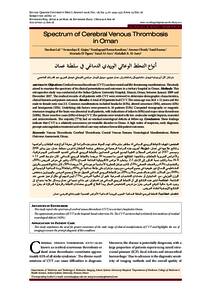Document
Spectrum of cerebral venous thrombosis in Oman.
Identifier
DOI: 10.18295/squmj.2018.18.03.011
Contributors
Gujjar, Arunodaya R., Author
Ramachandiran, Nandagopal., Author
Obaidi, Ammar., Author
Kumar, Sunil., Author
Other titles
أنواع التجلط الوعائي الوريدي الدماغي في سلطنة عمان
Publisher
College of Medicine, Sultan Qaboos University.
Gregorian
2018-08
Language
English
Subject
English abstract
Objectives: Cerebral venous thrombosis (CVT) can have varied and life-threatening manifestations. This study
aimed to examine the spectrum of its clinical presentations and outcomes in a tertiary hospital in Oman. Methods: This
retrospective study was conducted at the Sultan Qaboos University Hospital, Muscat, Oman, between January 2009 and
December 2017. The medical records of all patients with CVT were reviewed to determine demographic characteristics,
clinical features and patient outcomes. Results: A total of 30 patients had CVT. The mean age was 36.8 ± 11 years and the
male-to-female ratio was 2:3. Common manifestations included headache (83%), altered sensorium (50%), seizures (43%)
and hemiparesis (33%). Underlying risk factors were present in 16 patients (53%). Computed tomography or magnetic
resonance imaging of the brain was abnormal in all patients, with indications of infarcts (40%) and major sinus thrombosis
(100%). There were five cases (20%) of deep CVT. The patients were treated with low-molecular-weight heparin, mannitol
and anticonvulsants. The majority (77%) had no residual neurological deficits at follow-up. Conclusion: These findings
indicate that CVT is a relatively uncommon yet treatable disorder in Oman. A high index of suspicion, early diagnosis,
prompt anticoagulation treatment and critical care may enhance favourable patient outcomes
Member of
Resource URL
Citation
Lal, Darshan, Gujjar, Arunodaya R., Ramachandiran, Nandagopal, Obaidi, Ammar, Kumar, Sunil, El-Tigani, Mortada, Al-Azri, Faizal, & Al-Asmi, Abdullah R. (2018). Spectrum of Cerebral Venous Thrombosis in Oman, 18 (3), 329–337.
Arabic abstract
الهدف: التجلط الوريدي الدماغي له مظاهر متنوعة قد تهدد الحياة. هدفت هذه الدراسة إلى معرفة أنواع هذه الجلطات وأعراضها ونتائج علاجها في عمان. الطريقة: أجريت هذه الدراسة الرجعية في مستشفى جامعة السلطان قابوس، مسقط، عمان، بين يناير 2009 تم استعراض السجلات الطبية لجميع المرضى المصابين بالتجلط الوريدي الدماغي لتحديد الخصائص الديموغرافية، والأعراض السريرية للجلطات ونتائجها. النتائج: اصيب ما مجموعه 30 مريضا بالتجلط الوريدي الدماغي. كان متوسط العمر 11 ± 36.8 سنة وكانت نسبة الذكور إلى الإناث 2:3. وشملت الأعراض الاكلينيكية الشائعة الصداع (%83)، وتغير في حواس المريض (%50)، والتشنجات (%43) والضعف النصفي (%33). كانت عوامل الخطورة الأساسية موجودة في 16 مريضا (%53). كان نتائج التصوير بالرنين المغناطيسي للدماغ غير طبيعيه في جميع المرضى، مع وجود مؤشرات على جلطة دماغية في (%40) وتجلط الأوردة الدماغية الرئيسية في (100%) من الحالات، كانت هناك خمس حالات (%20) من التجلط الوريدي الدماغي العميق. تم علاج جميع المرضى بالهيبارين منخفض الوزن الجزيئي، مع المانيتول أو مضادات التشنجات الصرعية. ظهر أن غالبية المرضى (%77) ليس لديهم أي خلل أوعجز عصبي عند المتابعة. الخلاصة: تشير هذه النتائج إلى أن التجلط الوريدي الدماغي هو اضطراب غير شائع نسبيا في عمان وممكن علاجه بنجاح. إن وجود قدرة عالية لتوقع المرض يعزز من فرص التشخيص المبكر وبدأ العلاج الفوري بمضادات التجلط والرعاية المركزة قد يعزز من النتائج الإيجابية لشفاء المريض
Category
Journal articles

